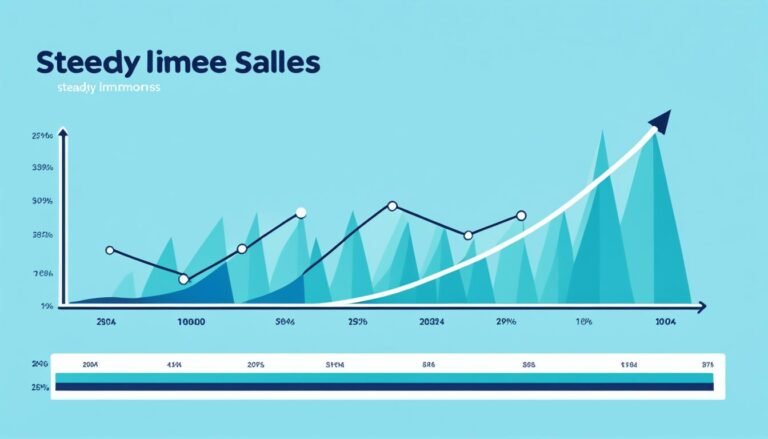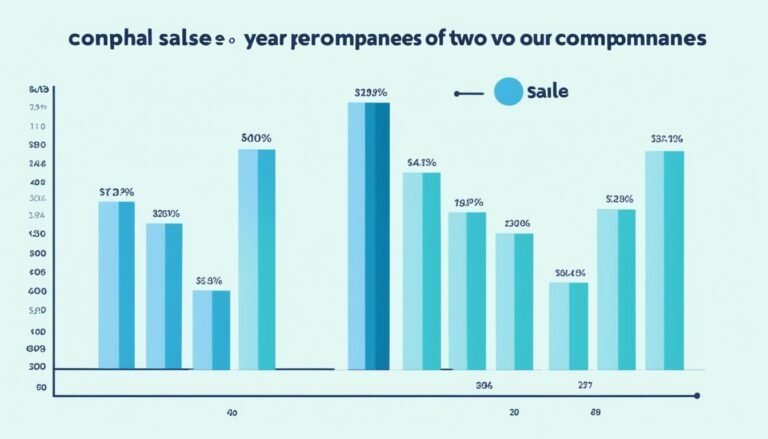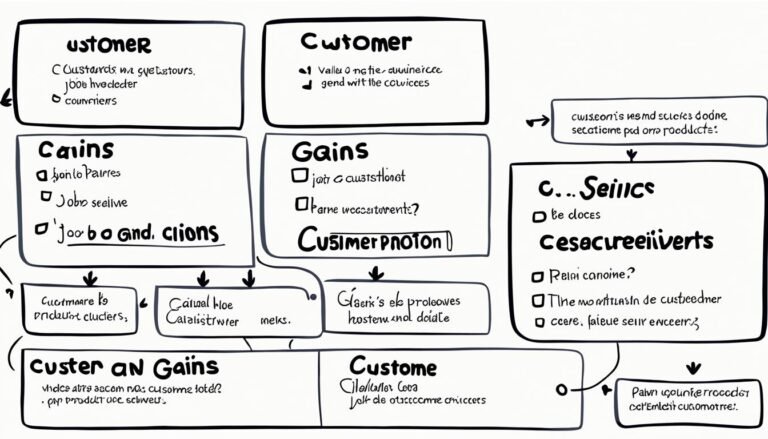Mastering Buyer Personas for Sales Success
Understanding buyer personas is essential for sales success. By analyzing data and empathizing with customers, marketers can establish a genuine connection and build trust. Buyer personas go beyond demographic information and delve into lifestyle choices, aspirations, and concerns. They help shape marketing and product development strategies to align with customer expectations. Collaborative efforts from various departments such as sales, customer service, and product development enhance the accuracy and effectiveness of buyer personas. These personas guide every aspect of business strategy, from product development to marketing campaigns to sales pitches.
Key Takeaways:
- Understanding buyer personas is crucial for sales success.
- Buyer personas go beyond demographics and delve into lifestyle choices, aspirations, and concerns.
- Collaboration between departments enhances the accuracy and effectiveness of buyer personas.
- Buyer personas guide every aspect of business strategy, from product development to marketing campaigns to sales pitches.
- By tailoring strategies to buyer personas, businesses can improve customer experience and boost sales.
The Philosophy Behind Buyer Personas
The philosophy behind buyer personas goes beyond surface-level demographics. To truly understand customers and foster a genuine connection, it is imperative to empathize with their lifestyles, aspirations, and concerns. By diving deep into these aspects, businesses can establish trust and form lasting relationships with their target audience.
Buyer personas are not just mere representations of a target market segment; they view the individual as a complete person with unique motivations and backgrounds. They provide a holistic understanding of customers, enabling businesses to tailor their marketing efforts and product offerings to suit their customers’ specific needs and desires.
Through buyer personas, businesses can gain valuable insights into customers’ lifestyle choices, such as their hobbies, interests, and preferred modes of communication. These personas also shed light on customers’ aspirations and concerns, helping businesses align their offerings with what their customers truly value.
By incorporating these key elements into buyer personas, businesses can create a solid foundation for building successful customer-centric strategies. The resulting understanding of customers’ needs and desires allows businesses to deliver personalized experiences, tailor their messaging, and address customers’ concerns effectively.
“Understanding buyer personas goes beyond demographics and taps into the heart of what motivates customers. It helps businesses create messaging and offerings that resonate on a deeper level.”
Ultimately, the philosophy behind buyer personas is rooted in the belief that by empathizing with customers, businesses can establish a genuine connection and build trust. This connection forms the basis for long-term customer loyalty and advocacy, driving both customer satisfaction and business growth.
Example Buyer Persona Profiles:
| Name | Age | Profession | Lifestyle Choices | Aspirations | Concerns |
|---|---|---|---|---|---|
| Emily | 35 | Marketing Manager | Yoga, Healthy Eating | Become a Thought Leader | Work-Life Balance |
| David | 45 | Small Business Owner | Golf, Fine Dining | Expand Business Operations | Financial Security |
| Sophia | 28 | Graphic Designer | Art, Travel | Freelance successfully | Job Stability |
Benefits of Creating Buyer Personas
Developing buyer personas offers several benefits for businesses. By gathering key information about customers, businesses can create profiles that reflect their common traits and preferences. These buyer personas play a crucial role in informing and shaping marketing and product development strategies.
By understanding the needs and expectations of their target audience, businesses can ensure that their marketing efforts and product offerings are aligned with customer preferences. This alignment leads to greater customer appreciation and satisfaction, ultimately driving sales and brand loyalty.
Improved Marketing Effectiveness
One of the key benefits of creating buyer personas is the ability to develop targeted marketing strategies. By understanding the specific characteristics and preferences of different buyer personas, businesses can tailor their marketing messages, channels, and tactics to resonate with their target audience. This personalized approach improves marketing effectiveness, as it allows businesses to deliver the right message to the right people at the right time.
Enhanced Product Development
Buyer personas also play a vital role in shaping product development strategies. By understanding the common traits and preferences of their target audience, businesses can prioritize product features and enhancements that align with customer expectations. This customer-centric approach ensures that the products meet the needs of the target audience, leading to higher customer satisfaction and increased sales.
Customer Satisfaction and Loyalty
When businesses develop marketing and product development strategies based on buyer personas, they are more likely to meet customer expectations. By addressing the common pain points and preferences of their target audience, businesses can provide a better customer experience. This, in turn, leads to higher levels of customer satisfaction and loyalty. Satisfied customers are more likely to become repeat customers and brand advocates, ultimately driving business growth.
| Benefits of Creating Buyer Personas | |
|---|---|
| Improved Marketing Effectiveness | Targeted marketing messages Resonates with the target audience Higher conversion rates |
| Enhanced Product Development | Alignment with customer expectations Higher customer satisfaction Increase in sales |
| Customer Satisfaction and Loyalty | Better customer experience Repeat customers and brand advocates Business growth |
Creating buyer personas provides businesses with valuable insights into their target audience. By understanding their customers’ common traits, preferences, and expectations, businesses can deliver personalized marketing campaigns and develop products that meet the needs of their customers. This customer-centric approach ultimately leads to enhanced marketing effectiveness, higher customer satisfaction, and increased brand loyalty.
Collaboration for Richer Personas
Creating buyer personas is a collaborative effort that involves inputs from various departments within a business, including marketing, sales, customer service, product development, and management. This multidisciplinary approach enriches the personas, making them more representative of the customer base.
Inputs from sales provide direct customer feedback, offering valuable insights into their preferences and pain points. Customer service, on the other hand, provides first-hand knowledge of customer satisfaction and complaints, helping to fine-tune the persona profiles.
Product development plays a crucial role in designing user-centric products that align with the needs and expectations of the target audience. By incorporating their insights into the buyer personas, businesses can ensure that their products resonate with customers.
Management’s involvement ensures that persona strategies align with overall business objectives. By leveraging the expertise of various departments, businesses gain a holistic view of their customers and can create more accurate and effective buyer personas.
Benefits of Collaboration for Buyer Personas:
- Enriches buyer personas with diverse perspectives and insights
- Ensures accuracy and authenticity in understanding customer motivations and preferences
- Drives alignment between various departments for coordinated and customer-centric strategies
- Enhances the effectiveness of marketing campaigns, sales pitches, and customer service protocols
| Collaborative Input | Department |
|---|---|
| Direct customer feedback | Sales |
| Insights into customer satisfaction and complaints | Customer Service |
| User-centric product design | Product Development |
| Alignment with overall business objectives | Management |
Beyond Theoretical Constructs
Buyer personas play a pivotal role in shaping every aspect of a business strategy. By understanding the needs and preferences of different customer segments, businesses can prioritize the development of product features, design targeted marketing campaigns, craft compelling sales pitches, and establish customer service protocols that resonate with their target audience.
However, buyer personas are not static constructs. They evolve alongside changing market dynamics and customer behaviors and preferences. In today’s fast-paced business landscape, agility and responsiveness are vital. Businesses must continuously adapt their strategies to align with the evolving needs of their buyers.
With a deep understanding of customer behavior and preferences, businesses can stay ahead of the competition and deliver exceptional products, personalized marketing messages, and seamless customer experiences. By staying agile and responsive to changes in buyer expectations, businesses can strengthen their position in the market and foster long-term customer loyalty.
| Aspect of Business Strategy | Impact of Buyer Personas |
|---|---|
| Product Development | Help prioritize features that resonate with target customers |
| Marketing Campaigns | Aid in determining the tone, messaging, and content that appeals to the target audience |
| Sales Pitches | Guide the creation of persuasive sales messages tailored to specific buyer personas |
| Customer Service Protocols | Enable businesses to provide personalized and efficient customer support experiences |
By adopting an agile and responsive approach to buyer personas, businesses can anticipate and adapt to changes in customer behavior and preferences, making informed decisions that drive success.
Building a Robust Persona Template
A comprehensive buyer persona template is essential for understanding different customer segments and creating targeted strategies. It goes beyond basic demographic data and incorporates both tangible and intangible customer attributes. By considering factors such as lifestyle choices, media consumption habits, decision-making processes, and emotional triggers, businesses can gain a deeper understanding of their target audience.
With a well-defined buyer persona template, businesses can:
- Develop Tangible Attributes: Capture information about customers’ demographics, including age, gender, occupation, education level, and geographic location. These tangible attributes contribute to shaping a solid foundation for persona profiles.
- Explore Intangible Attributes: Dive deeper into customers’ preferences, values, beliefs, aspirations, and pain points. Understanding customers’ intangible attributes provides insightful cues for effective marketing and product development strategies.
- Uncover Lifestyle Choices: Analyze customers’ hobbies, interests, activities, and personal goals. This insight helps tailor marketing messages and product offerings to align with customers’ lifestyles.
- Study Media Consumption Habits: Explore the platforms, channels, and sources of information that customers rely on. This knowledge enables businesses to position their products or services in front of target customers effectively.
- Map Decision-Making Processes: Understand the factors customers weigh when making purchasing decisions. By identifying key influencers, motivators, and obstacles, businesses can craft strategies that facilitate the decision-making process.
- Identify Emotional Triggers: Unveil customers’ emotional needs and triggers, helping you communicate and connect with them on a more personal level.
- Create Targeted Strategies: Armed with this comprehensive understanding of customers, businesses can develop tailored marketing campaigns, personalized offers, and customer-centric experiences that resonate with their target audience.
A robust persona template serves as a blueprint for businesses, empowering them to meet customer expectations, enhance brand loyalty, and drive sales growth. By continually refining and updating the template based on market trends and changing customer behaviors, businesses can stay agile and responsive in their efforts to connect with their target audience.
“Building a robust buyer persona template is the first step towards understanding your customers on a granular level. It allows businesses to craft targeted strategies that speak directly to their audience’s needs and aspirations.”
Research Techniques for Realistic Personas
When creating buyer personas, research techniques are instrumental in ensuring realistic and accurate representations of the target audience. By employing various methods, marketers can gain deeper insights and develop a nuanced view of customer preferences and behaviors. Here are the key research techniques that contribute to crafting realistic buyer personas:
1. Surveys
Surveys allow businesses to collect direct feedback from their target audience. By asking specific questions, businesses can gather valuable information about customer needs, preferences, and pain points. Surveys provide quantitative data that can be analyzed to identify patterns and trends within the target audience.
2. Interviews
Interviews provide an opportunity to engage directly with customers and delve deeper into their motivations and behaviors. Through open-ended questions, businesses can capture qualitative data that offers rich insights. Interviews also allow for follow-up questions, enabling a deeper understanding of customer needs and desires.
3. Analyzing Social Media Trends
Social media platforms offer a wealth of data that can be mined to understand customer preferences and behaviors. By analyzing social media trends, businesses can uncover patterns in consumer conversations and sentiment. This information helps in identifying emerging trends and crafting targeted marketing strategies.
4. Customer Feedback
Customer feedback is a valuable resource for understanding customer satisfaction and uncovering pain points. By proactively soliciting feedback and consistently monitoring reviews, businesses can gain insights into customer experiences. This information aids in refining buyer personas and developing customer-centric approaches.
5. Advanced Analytics and AI Tools
The advancements in analytics and AI tools offer powerful capabilities for analyzing large datasets. By leveraging these tools, businesses can delve deeper into customer data and uncover hidden patterns and correlations. Advanced analytics and AI tools provide businesses with a more comprehensive understanding of customer behaviors, enabling the creation of more realistic buyer personas.
By employing these research techniques, businesses can gather the necessary insights to create accurate and realistic buyer personas. These personas serve as a foundation for targeted marketing, product development strategies, and personalized customer experiences. Now, let’s look at how these personas can be further refined through interviews in the next section.

The Art of Conducting Interviews
Conducting interviews for persona development requires empathy and an open mind. Interviewers should aim to understand the “why” behind customer behaviors and preferences. This qualitative data, combined with quantitative insights, forms the foundation of a reliable and authentic buyer persona.
When approaching interviews, it’s important to create a comfortable and non-judgmental environment. Make your interviewee feel at ease by starting with friendly conversation and actively listening to their responses. Use open-ended questions to encourage detailed responses and gain a deeper understanding of their motivations and pain points.
“We conducted interviews with a diverse range of customers and prospects from different age groups and backgrounds. Through these conversations, we gained invaluable insights into their needs, aspirations, and challenges. The interviewees felt heard, and this built trust, allowing us to create accurate and detailed buyer personas.”
During interviews, pay attention to verbal and non-verbal cues that reveal underlying emotions, motivations, and decision-making factors. Understanding the emotional triggers that drive customer behavior is crucial for developing effective marketing and sales strategies.
It’s also essential to ask follow-up questions to clarify and dive deeper into specific topics. Probe for examples and stories that offer context and provide valuable qualitative data.
Best Practices for Conducting Interviews:
- Prepare a set of well-thought-out questions to guide the conversation and ensure you cover all relevant topics.
- Establish a comfortable and welcoming environment to encourage open and honest responses.
- Active listening is key – take notes, ask for clarification, and show genuine interest in the interviewee’s experiences.
- Ask open-ended questions to facilitate in-depth responses and uncover valuable insights.
- Follow-up with probing questions to gain a deeper understanding of motivations and decision-making processes.
Continual Adaptation and Refinement
Buyer personas are not static and require continual adaptation and refinement to remain relevant. Regular reviews and updates ensure that personas evolve in tandem with market trends and customer behaviors, maintaining their effectiveness in guiding business strategies.
As market trends and customer behaviors continuously evolve, businesses must adapt their buyer personas to stay in sync with their target audience. Regularly reviewing and updating the personas allows companies to incorporate the latest insights and observations, ensuring that the personas accurately reflect the changing needs and preferences of customers.
By regularly reviewing and updating buyer personas, businesses can refine their understanding of their target audience and tailor their strategies accordingly. Refinement enables companies to stay ahead of market trends and customer behaviors, enhancing their competitive advantage and improving their chances of success.
Market trends provide valuable insights into customer preferences and expectations. By monitoring market trends and aligning buyer personas with these trends, businesses can position themselves as relevant and responsive to the changing needs of their target audience.
Closely observing customer behaviors is also crucial for the adaptation and refinement of buyer personas. By analyzing how customers interact with products and services, businesses can identify any shifts in their behaviors, preferences, and pain points. This understanding enables companies to update their personas to better address these changing customer needs.
Regular reviews and updates of buyer personas demonstrate a commitment to staying current and customer-focused. It ensures that businesses remain agile and responsive in their strategies, staying in tune with the ever-evolving marketplace.
Overall, the continual adaptation and refinement of buyer personas is essential for businesses to effectively navigate changing market trends and customer behaviors. By regularly reviewing and updating these personas, companies can ensure that their strategies align with the evolving needs and preferences of their target audience, ultimately driving their success in the market.
Applying Personas for Your Business
Buyer personas play a crucial role in various aspects of business, including branding, marketing, and advertising. They serve as a compass in strategic planning, guiding decisions regarding product development, marketing strategies, and sales approaches. By keeping buyer personas in mind, businesses can ensure that their strategies are customer-centric and aligned with the preferences and pain points of their target audience.
Table: Applying Personas in Business
| Area of Business | Application of Buyer Personas |
|---|---|
| Branding | Creating a brand identity that resonates with the target audience’s preferences and values. |
| Marketing | Crafting targeted messages and campaigns that speak directly to the needs and motivations of the buyer personas. |
| Advertising | Selecting the most effective channels and platforms to reach the target audience based on their media consumption habits. |
| Strategic Planning | Using buyer personas as a guiding framework to align business objectives with the needs and expectations of the target audience. |
| Product Development | Designing and refining products that address the pain points and desires of the buyer personas. |
| Customer-Centric Approaches | Building customer experiences, tailored to the buyer personas, to foster loyalty and satisfaction. |
Image:
Conclusion
Understanding buyer personas is crucial for achieving sales success in today’s competitive market. By gaining a deep understanding of your target customers’ needs, preferences, and pain points, businesses can develop customer-centric marketing strategies that drive growth. Personalized messaging that resonates with your audience on an emotional level can enhance the customer experience and foster long-lasting relationships.
By crafting relevant sales strategies based on buyer personas, businesses can tailor their approach to meet the specific needs of their target customers. This not only increases the effectiveness of sales efforts but also improves customer satisfaction. When customers feel understood and valued, they are more likely to engage with your brand and make a purchase.
The journey to master buyer personas is an ongoing process that requires continual refinement and adaptation. Regularly reviewing and updating your buyer personas based on market trends and changing customer behaviors is crucial for maintaining their effectiveness. By treating buyer personas as a strategic imperative and constantly refining your understanding of your target customers, you can create a customer-centric business that thrives in today’s dynamic marketplace.







